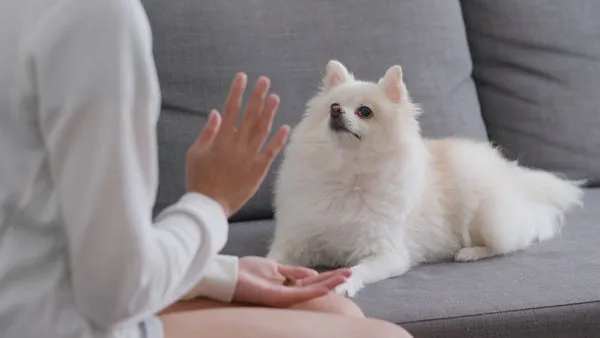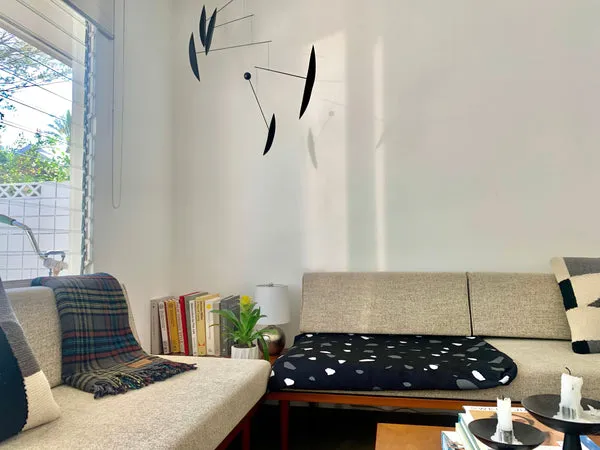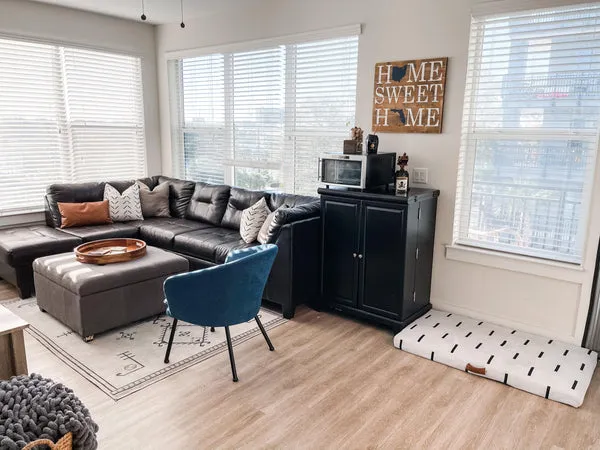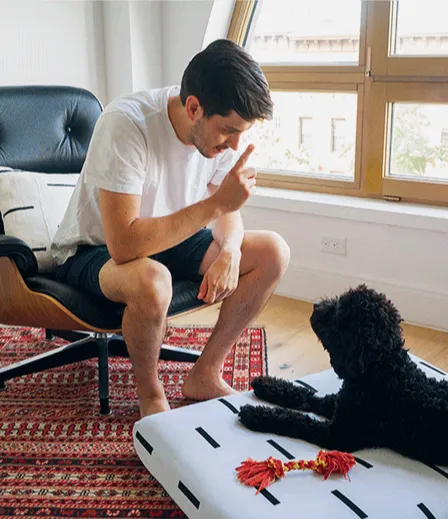For many dog owners, the dilemma of a furry friend lounging on the sofa is a familiar one. While some embrace it, others prefer their furniture to remain a dog-free zone. Deciding on the ground rules for couch time is a significant part of training your dog, whether you have a playful puppy or an older companion. The good news is that this is a reasonably straightforward training process that can often be achieved in just a few days, depending on your consistency and dedication.
If you’re wondering How To Train My Dog To Stay Off The Couch, this guide will walk you through the most common and effective methods to ensure your dog understands and respects the boundaries of your furniture. Establishing clear expectations from the start will benefit both you and your canine companion, leading to a harmonious living environment. You’ll learn practical strategies, from physical barriers to command-based training, that will help you achieve your goal. Understanding how to stop a dog jumping on the couch is the first step towards a well-behaved pet.
The Block Method: Preventing Access
One of the simplest and most direct approaches to keeping your dog off the couch is the block method. This technique literally prevents your dog from even getting close to the forbidden furniture. When you are at home, you can simply take up all the available space on the sofa yourself. If there’s no room for your pup to jump onto, they won’t feel the urge to get on the couch in the first place.
For times when you are not actively using the couch or are away from home, you can employ various physical barriers. Utilizing baby gates, large decorative objects, or even a strategically placed pile of pillows can effectively block the couch space. Many home décor options are available that won’t disrupt your aesthetic, such as stylish pet gates or ottomans that can be moved to block an entryway. This method is particularly helpful for older dogs who may have already developed a habit of lounging on the furniture, as it removes the opportunity for them to do so.
 Pet gate blocking access to a room with a couch
Pet gate blocking access to a room with a couch
Teaching Commands: The “Off” and “Up” Methods
While the block method is practical for immediate prevention, it doesn’t fully train your dog with commands. For a more comprehensive solution, focus on teaching your dog specific verbal cues. The “off” and “up” commands are two essential tools for managing your dog’s interaction with the couch.
The “Off” Command
To teach the “off” command, sit in your living room and observe your dog. The moment they attempt to hop onto the furniture or are already on it, approach them with a treat or their favorite toy. Clearly and firmly use the word “off” to indicate that you want them to get down. Lure them off the furniture and onto the floor using the treat or toy. As soon as all four paws are on the ground, immediately reward them with praise and the treat. Consistently repeat this process, rewarding them every time they respond correctly, until your dog understands and responds reliably to the “off” command.
 A dog being lured off a couch with a treat
A dog being lured off a couch with a treat
The “Up” Command
Some owners prefer to allow their dogs on the couch occasionally, especially for cuddle time. In these cases, teaching the “up” command is beneficial. This command teaches your dog that they can only get on the furniture when invited. You can designate a specific spot on the couch, perhaps with a blanket or a dog bed cover, for them to use.
 A dog comfortably resting on a dog bed cover on a couchTo teach “up,” you might find it helpful to use a leash. With your dog on the leash, enthusiastically say “up!” and pat the area where you want them to jump. Wiggle a favorite toy or a treat to entice them. If they hesitate, gently pull the leash upward to guide them onto the spot. The moment they make it, reward them with praise and a treat. This also provides an excellent opportunity to reinforce the “off” command immediately after they are on the couch, ensuring they understand that getting on and off is done only with your permission. By teaching them to wait for an invitation, you maintain control over their access to the furniture. Learning [how to train your dog to walk off leash](https://dogcarestory.com/how-to-train-your-dog-to-walk-off-leash/) also requires consistent command training, similar to teaching “up” and “off.”
A dog comfortably resting on a dog bed cover on a couchTo teach “up,” you might find it helpful to use a leash. With your dog on the leash, enthusiastically say “up!” and pat the area where you want them to jump. Wiggle a favorite toy or a treat to entice them. If they hesitate, gently pull the leash upward to guide them onto the spot. The moment they make it, reward them with praise and a treat. This also provides an excellent opportunity to reinforce the “off” command immediately after they are on the couch, ensuring they understand that getting on and off is done only with your permission. By teaching them to wait for an invitation, you maintain control over their access to the furniture. Learning [how to train your dog to walk off leash](https://dogcarestory.com/how-to-train-your-dog-to-walk-off-leash/) also requires consistent command training, similar to teaching “up” and “off.”
The Spot or Place Method: Offering an Alternative
Another highly effective way to keep your dog off the couch is to provide them with an appealing alternative. Designating a specific “spot” or “place” for them, such as a comfortable dog bed in the same room as your couch, can redirect their desire to lounge. Modern dog beds can even complement your home décor, making it easy to keep them close to the couch.
 A stylish dog bed placed on the floor in a living room
A stylish dog bed placed on the floor in a living room
Implementing the “Place” Command
When your dog approaches the couch, say “place” and gently lure them toward their designated bed. You can use small treats to create a positive association with their spot, dropping them along the path to the bed or placing them directly on it. For more stubborn dogs, a leash can be used to gently guide them to their bed. As your dog begins to recognize and respond to the “place” command, you can gradually reduce the reliance on treats for luring.
To solidify the training, start rewarding your dog for choosing their bed over the sofa. When you enter the living room, observe your dog’s behavior. If they go directly to their bed instead of the couch, immediately reward them with praise and a treat. This positive reinforcement helps your dog understand that the sofa is an off-limits zone and that their bed is their comfortable, acceptable lounging area. Teaching your dog a “place” command can also complement training like how to train my puppy to walk by establishing general obedience.
What to Do When You’re Not Home
Even after your dog has mastered staying off the couch when you’re present, the moment you leave, their true intentions might surface. Many dog owners have witnessed their pets happily hopping onto the sofa via security cameras. Preventing this unsupervised couch time is crucial for consistent training. Best way to stop dog from jumping on door shares principles of managing access, which applies here.
The easiest way to ensure your dog stays off the couch while you’re away is by blocking access entirely. This can involve placing a baby gate in the doorway leading to the living room or teaching your dog crate training for when you leave the house. Crate training is an effective method to prevent destructive behavior and keep your dog safely off furniture. While it might seem challenging at first, learning to crate train your dog can be highly beneficial for both of you, providing a secure and comfortable space for your pup. If crating isn’t an option, consider using deterrents to gauge your dog’s reaction and their effectiveness.
Remember, consistency and a steady approach are paramount in all dog training. Sending mixed signals will only confuse your dog and hinder progress. Ensure every member of your household is on the same page regarding the rules for the couch and actively participates in reinforcing the training. This collective effort will significantly improve your dog’s understanding and adherence to the boundaries you set. Just as you would train your dog to not pull on leash, consistency is key to success.
 A person gently guiding a dog on a leash towards a designated spot
A person gently guiding a dog on a leash towards a designated spot
Conclusion
Successfully training your dog to stay off the couch involves a combination of clear communication, consistent reinforcement, and sometimes, physical barriers. By implementing methods such as the block technique, teaching definitive “off” and “up” commands, and providing an attractive alternative like a designated “place” or dog bed, you can guide your canine companion to respect your furniture boundaries. Managing unsupervised access through gates or crate training is also vital for maintaining consistency. Remember that patience, consistency, and positive reinforcement are your most powerful tools in any dog training endeavor. With a unified approach from all household members, your dog will quickly learn and adhere to the rules, creating a more harmonious home for everyone. If you require expert guidance, enrolling in professional online dog training can provide tailored support and convenient learning to help you achieve your training goals.
